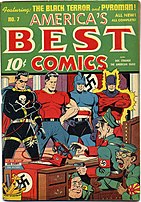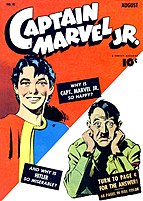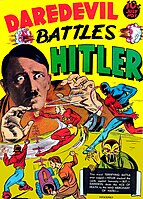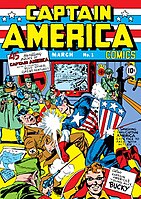Adolf Hitler in popular culture

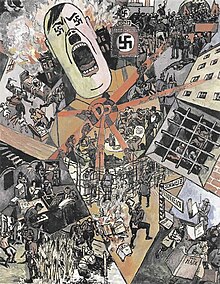
Adolf Hitler (20 April 1889 – 30 April 1945) was the leader of the Nazi Party and Chancellor of Nazi Germany from 1933 (Führer from 1934) to 1945. Hitler has been represented in popular culture ever since he became a well-known politician in Germany. His distinctive image was often parodied by his opponents. Parodies became much more prominent outside Germany during his period in power. Since the end of World War II representations of Hitler, both serious and satirical, have continued to be prominent in popular culture, sometimes generating significant controversy.[1][2] In many periodicals, books, and movies, Hitler and Nazism fulfill the role of archetypal evil.[3][4] This treatment is not confined to fiction but is widespread amongst nonfiction writers who have discussed him in this vein.[5][6][7][8] Hitler has retained a fascination from other perspectives; among many comparable examples is an exhibition at the German Historical Museum which was widely attended.[9]
Representations of Hitler during his lifetime[]

Numerous works in popular music and literature feature Adolf Hitler prominently.
In Germany, before he came to power, Hitler was often portrayed satirically in newspaper cartoons and propaganda by political enemies.[10][11] The photomontagist John Heartfield regularly depicted Hitler in absurd ways in his anti-Nazi poster designs. After the Nazis came to national power in January 1933, Hitler was mostly depicted as a god-like figure, loved and respected by the German people, as shown for example in Triumph of the Will, which Hitler co-produced.[12] An exception was the German film Das Testament des Dr. Mabuse (The Testament of Dr. Mabuse) from 1933, which was banned by the Nazi propaganda ministry.[13] Many critics consider Fritz Lang's depiction of a homicidal maniac masterminding a criminal empire from within the walls of a criminal asylum to be an allegory of the Nazi ascent to power in Germany.[14]
Outside Germany Hitler's persona was often parodied. George Bernard Shaw's 1936 play Geneva includes a caricature of Hitler as Herr Battler, appearing at an international tribunal with his friends Signor Bombardone (Mussolini) and General Flanco (Franco). There are numerous cartoons satirising his distinctive features, such as those by David Low.[15][16]
After the start of the war[]
Another early example of a cryptic depiction is in Bertolt Brecht's 1941 play, The Resistible Rise of Arturo Ui, in which Hitler, in the persona of the principal character Arturo Ui,[17] a Chicago racketeer in the cauliflower trade, is ruthlessly satirised. Brecht, who was German but left when the Nazis came to power, also expressed his opposition to the National Socialist and Fascist movements in other plays such as Mother Courage and Fear and Misery of the Third Reich.[18]
Outside Germany, Hitler was made fun of or depicted as a maniac. There are many notable examples in contemporary Hollywood films. Several Three Stooges shorts, the first being You Nazty Spy! (1940), the very first Hollywood work lampooning Hitler and the Nazis in which the boys, with Moe Howard portraying "Moe Hailstone", as the Hitler character, are made dictators of the fictional country of Moronika.[19] This short in particular implies that business interests were behind Hitler's rise to power, and was said to be Moe Howard's and Larry Fine's favorite Stooges short subject.[20] A sequel was released a year later entitled I'll Never Heil Again. This one illustrated the disagreements between Hitler and the League of Nations. In other Three Stooges shorts, Hitler is referred to as "Schicklgruber" in reference to his father Alois Hitler's birth name. First released some nine months after the Stooges' initial Nazi-lampooning short subject, Charlie Chaplin made fun of Hitler as "Adenoid Hynkel," the buffoonish dictator of Tomainia, in his 1940 film The Great Dictator.[21] This is one of the most recognizable Hitler parodies.[22]
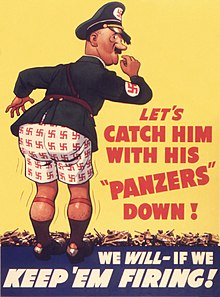
Especially during World War II, Hitler was caricatured in numerous animated shorts, including Der Fuehrer's Face, a 1942 Disney wartime propaganda cartoon featuring Donald Duck (inspired by Spike Jones' playing of the song written by Oliver Wallace), and the Warner Bros. cartoon Herr Meets Hare featuring Bugs Bunny. However, Hitler's first appearance on a Warner Brothers cartoon was in Bosko's Picture Show in 1932 in a short gag where Hitler is shown chasing after Jimmy Durante with an ax. George Grosz painted Cain, or Hitler in Hell (1944) showing the dead attacking Hitler in Hell. The photomontage artist John Heartfield made frequent use of Hitler's image as a target for his brand of barbed satire during Hitler's lifetime. In Fritz Lang's 1941 movie Man Hunt, which opened in theaters before America's entry into the war, Hitler is seen in the scope of a British hunter's rifle. In Ernst Lubitsch's 1942 films To Be or Not to Be (as well as in Mel Brooks' remake in 1983), an actor from a Polish stage group impersonates Hitler to enable the escape of the troupe to England.
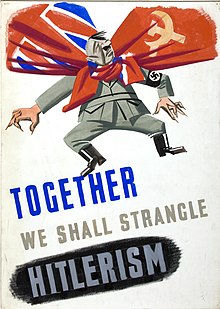
Apart from Hollywood films, Hitler was the subject for several comic book superheroes who battled Hitler directly or indirectly in comics published during World War II. Superheroes that fought Hitler include Superman, Captain America, the Shield, and Namor the Sub-Mariner. The first Captain America comic showed Captain America hitting Hitler on the jaw. Captain America's archenemy, the Red Skull, was established as being an apprentice to Hitler. In Superman #15 the dictator Razan appeared, who attempted to invade a nearby democratic nation. Superman defeated his army, and Razan was shot while trying to escape.
Hitler was mocked in satirical folk songs such as "Stalin Wasn't Stallin'" or when new lyrics were created to old songs such as "Hitler Has Only Got One Ball" (to the tune of the "Colonel Bogey March").
Representations of Hitler after his death[]

After his death, Hitler continued to be depicted as incompetent or foolish. However, while Hitler's anti-Semitic policies were well known during his lifetime, it was only after his death that the full extent of the Holocaust and other Nazi genocides became known.[23] This, coupled with Hitler no longer being a threat, has meant that the way he is depicted in popular culture has resulted in Hitler being personified as evil.
The 2003 television film Hitler: The Rise of Evil stars Robert Carlyle in the title role and depicts a semi-fictional account of Hitler's life from childhood to the new position of Führer und Reichskanzler, completing his ascension to full totalitarian, dictatorial power in Germany. However, the film has been criticized for its many inaccuracies in portraying Hitler's temperament and related events, to the point that it has been likened to fiction.
Moloch (1999), directed by Alexander Sokurov, starring , deals with Hitler's life on his Berghof mountain retreat near Berchtesgaden during the war, drawing heavily from Hitler's Table Talk published after the war.
Hitler's last days have been depicted in several films, first in Der letzte Akt (1955), directed by Georg Wilhelm Pabst, starring Albin Skoda as the dictator; next was the fifth and final installment of the Soviet film series Liberation (1969–72), directed by Yuri Ozerov, starring Fritz Diez (an actor who commonly portrayed Hitler in a number of East German films from 1955 onwards). The Death of Adolf Hitler, a British (7 January 1973) made-for-television production, starring Frank Finlay in the title role, and Hitler: The Last Ten Days (1973), directed by Ennio de Concini, starring Sir Alec Guinness were the first Western contributions. The fifth iteration was the U.S. television film The Bunker (1981), directed by George Schaefer, starring Sir Anthony Hopkins. Finally, there was the Academy Award–nominated Downfall (2004), directed by Oliver Hirschbiegel and starring Bruno Ganz as Hitler. Also depicting Hitler's final hour in the bunker, the short film Hundert Jahre Adolf Hitler - Die letzte Stunde im Führerbunker (1989), directed by Christoph Schlingensief, starring Udo Kier, cannot be considered a remake of the above films in the proper sense.[why?]
Hitler was portrayed in the television miniseries Inside the Third Reich (1982) by Sir Derek Jacobi, who was nominated for an Emmy Award for his performance. Hitler was also portrayed in the film Valkyrie by David Bamber, which tells the story of the July 1944 bomb attempt on his life.[24]
Another example of Hitler representations are comedy films such as Mel Brooks' comedy The Producers featured a satirical play-within-a-play called Springtime for Hitler, featuring dancing Nazis and songs about the conquest of Europe. Brooks' later comedy, History of the World, Part I, featured "Hitler on Ice."
Hitler has also been portrayed in experimental films. Hitler: A Film from Germany (1978), a 4-part, 442-minute experimental film on Hitler, directed by Hans-Jürgen Syberberg, starring Heinz Schubert. A similar non-linear approach to Syberberg's, likening Hitler to a movie director as well, was used in the film The Empty Mirror (1996), directed by , starring Norman Rodway, which speculates about Hitler surviving World War II, living in a secret subterranean bunker, and is today undergoing psychoanalysis conducted by Sigmund Freud.
Kosovar Emin Xhinovci has attracted considerable media attention for his striking resemblance to Hitler, and subsequent impersonation of him.[25]
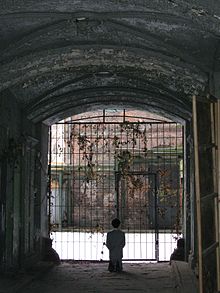
Him (2001) is a sculpture resembling a schoolboy kneeling in prayer, except that the head has been replaced with the realistic likeness of Adolf Hitler. The sculpture was frequently displayed at the end of a long hallway or at the opposite end of a white room, turned away from the viewer so that they wouldn't be able to recognize the individual until they advanced close enough. The artist's proof of Him (2001) was sold at auction by Christie's in 2016 for $17,189,000.[26]
Hitler in fiction[]
WorldCat lists 553 published books under this heading.[27]
Novels[]
- Ron Hansen's historical fiction novel Hitler's Niece parallels Hitler's rise to power in the 1920s and 1930s with his relationship with his niece (and secret mistress) Geli Raubal.
- In the novel Young Adolf (1978) by English author Beryl Bainbridge, the 23-year-old Hitler travels to Liverpool to visit his English relatives.
- The 1962 short story Genesis and Catastrophe: A True Story by Roald Dahl portrays an unhappy husband in Austria in 1889 whose wife is about to give birth. The father is pessimistic about the child's survival as their previous three children have all died in infancy. Rebuked by the doctor for his gloominess, his confidence is boosted by his wife's conviction that their new baby, a boy, will survive. The father names his newborn son Adolf Hitler.
- In the novel (2014) by English author D. M. Thomas, a young Hitler (going by the nom de guerre 'Wolf') becomes involved with Anna Freud and her father Sigmund whilst residing in Vienna.
Hitler appears in many alternate history novels.
- In Philip K. Dick's 1962 The Man in the High Castle, Hitler, after being stricken by the later stages of syphilis, was confined to a lunatic asylum shortly after World War II, and his place taken by Martin Bormann and, later, Joseph Goebbels and possibly Reinhard Heydrich.
- Similarly, in Eric Norden's 1973 The Ultimate Solution Nazi Germany won the war and rules the world, but Hitler personally got little benefit of it. Having gone entirely mad, he is kept closely confined, constantly shouting at uncaring guards that he had been betrayed - while a double is taking his place in public ceremonies.
- In Nancy Kress' And Wild for to Hold [28] time-travelers intervene to change the past. Rather than assassinate Hitler, the humane emmissaries from the future kidnap him alive from the year 1932, and keep him captive under comfortable conditions; Hitler spends his time mainly reading Science Fiction Space Opera novels for which he developed a taste. In his absence, 1933 comes and passes with no dictatorship in Germany and no persecution of Jews.
- In Norman Spinrad's 1972 alternate history novel The Iron Dream, Hitler in the early 1920s stopped dabbling in politics, emigrated to America, learned English and became a well-known and respected science fiction pulp novelist - author of Lord of the Swastika, the text of which provides the bulk of the book.
- In the controversial 1981 novella The Portage to San Cristobal of A.H. by George Steiner Hitler survives the end of the war and escapes to the Amazon jungle, where he is found and tried by Nazi-hunters 30 years later. Hitler's defence is that since Israel owes its existence to the Holocaust, he is really the benefactor of the Jews.
- In Irving Wallace's The Seventh Secret (1985), Hitler and Eva Braun survive World War II by having doubles (a comedian named Manfred Müller and his girlfriend) murdered in their place (by Martin Bormann and others) staging the murder to look like suicide.
- In Ira Levin's 1976 The Boys from Brazil, Hitler conspired with Josef Mengele to clone himself prior to his death. Using Hitler's blood, Mengele begins a project in the 1960s to clone several Hitlers and distribute the Hitler infants to families similar to that of the original. Mengele later attempts to recreate the sociological environment of Hitler's youth, beginning with killing the fathers of all the Hitler clones. Mengele's plan is to eventually create a second Hitler who will come of age in the 21st century and establish the Fourth Reich.
- Forged journals of Hitler, known as the Hitler Diaries, were published in West Germany by the magazine Stern in 1983.
- The 1995 Robert Ludlum novel The Apocalypse Watch meets its climax with the destruction of a Fourth Reich set in the 1990s, and the discovery of an ancient Adolf Hitler controlling a massive multinational corporation.
- Robert Harris' 1992 novel Fatherland is based on a fictional German victory in WWII and Hitler meeting with U.S. President Joseph P. Kennedy during the 1960s.
- In The Plot Against America (2004), Philip Roth envisions what life would have been like in the United States had Charles Lindbergh defeated Franklin D. Roosevelt and became President during the 1940s, allying America with Nazi Germany.
- Hitler is also the main 'protagonist' in the German dark satire novel Er ist wieder da ("Look Who's Back") by Timur Vermes, published in 2012. Hitler is shown to somehow reawaken, alive again, in Berlin of 2011 and, since no one believes him to really be Hitler, becomes popular on YouTube as a Hitler impersonator.[29][30]
- Lavie Tidhar's novel, A Man Lies Dreaming (2014) features a thinly-disguised Hitler (going by the nom de guerre 'Wolf' - which Hitler used during the 1920s) as a down-at-heels private eye in a 1930s London, in a world where the communists, rather than the Nazis, came to power in Germany.
Theatre[]
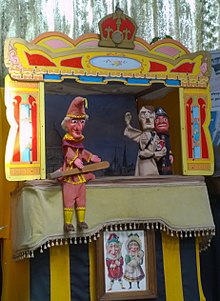
Hitler made it onto the stage through Japanese novelist Yukio Mishima, who wrote a play called My Friend Hitler (Wagatomo Hitora), retelling the Night of the Long Knives. Moreover, the Hungarian writer George Tabori wrote a comedy called Mein Kampf which portrayed Hitler as a poor young man who enters Vienna, wanting to become an artist. Hitler appears as a minor character in Stanley Eveling's The Dead of Night, set above the Führerbunker as the Russians are entering Berlin. Dr Freud Will See You Now Mr Hitler (2008) was a radio drama by Laurence Marks and Maurice Gran presenting an imagined scenario in which Sigmund Freud treats the young Hitler. Toby Jones played Hitler. Utpal Dutt's 1975 Bengali play Barricade is set in the time that Hitler is rising to power.
Film[]
- Bobby Watson played Hitler in
- The Devil with Hitler (1942)
- Hitler – Dead or Alive (1942)
- That Nazty Nuisance (1943)
- The Miracle of Morgan's Creek (1944)
- The Hitler Gang (1944)
- A Foreign Affair (1948)
- The Story of Mankind (1957)
- On the Double (1961)
- The 4 Horsemen of the Apocalypse (1962)
- The Ace of Aces (1982), Günter Meisner plays Hitler and Hitler's half-sister Angela
- Blazing Saddles (1974): an actor playing Hitler in a film eats at the Warner Bros. commissary
- The Boys from Brazil (1978): a madman clones Hitler
- The Bunker (1981), played by Anthony Hopkins
- BloodRayne: The Third Reich (2011), played by Boris Bakal
- Bosko's Picture Show (1933): Hitler chases Jimmy Durante with an axe.
- Captain America: The First Avenger (2011): Steve Rogers performs in a war bond tour in which he "knocks out" Hitler; he tells the members of Bucky Barnes’ unit "I've knocked out Adolf Hitler over 200 times!"
- Carl Ekberg played Hitler in
- Citizen Kane (1941)
- Man Hunt (1941)
- The Wife Takes a Flyer (1942)
- Once Upon a Honeymoon (1942)
- What Did You Do in the War, Daddy? (1966)
- Chaplin (1992): Charlie Chaplin refuses to shake hands with man discussing Hitler at a party and discusses him with his brother Sidney during pre-production on The Great Dictator
- Countdown to War (1989), played by Ian McKellen[31]
- Daffy – The Commando (1943): Daffy Duck hits Hitler on the head with a mallet
- Deadpool 2 (2018): During the post-credits scene (extended cut only), Deadpool uses Cable’s time travel device to kill Hitler as a baby.
- Dear Friend Hitler (2011), played by Raghuvir Yadav
- The Death of Adolf Hitler (1973), played by Frank Finlay
- Fritz Diez played Hitler in
- Ernst Thälmann – Führer seiner Klasse (1955)
- Frozen Flashes (1967)
- I, Justice (1967)
- Liberation (1970–1)
- Seventeen Moments of Spring (1973)
- Take Aim (1974)
- Soldiers of Freedom (1977)
- Dragon Ball Z: Fusion Reborn (1995): Hitler escapes from Hell and attempts to take over a city
- The Empty Mirror (1996), played by Norman Rodway
- Europa, Europa (1990), played by Ryszard Pietruski
- Fatherland (1994), directed by Christopher Menaul
- Fullmetal Alchemist the Movie: Conqueror of Shamballa (2005): Edward learns from Lang that the Thule Society plans to use the weapons from his world to help Hitler in his attempt to start a revolution
- The Good Shepherd (2006): Fredericks takes Wilson to a meeting where Hitler is discussed; Murach recruits Wilson to expose Fredericks as a Nazi
- The Great Dictator (1940): Adenoid Hynkel is a parody of Hitler
- Hellboy (2004): New BPRD agent John Myers is told Hitler died in 1958, not in 1945
- Hitler (1962), played by Richard Basehart
- Hitler, ein Film aus Deutschland (1977) documentary by Hans-Jürgen Syberberg[32]
- Hitler: The Last Ten Days (1973), played by Alec Guinness
- Hitler Umanath (1982): a timid man who resembles Hitler becomes a leader
- Hitler's Brain and the Robot from Hell (2015): A scientist inadvertently resurrects Hitler by inserting his brain into a robot meant for another historical figure
- Hitler's SS: Portrait in Evil (1985), played by Colin Jeavons
- The Three Stooges Moe Howard parodied Hitler as "Moe Hailstone" in two of the Stooges' short subject films:
- You Nazty Spy!, the first Hollywood film work to lampoon Hitler, released nine months (January 1940) before The Great Dictator[33][self-published source?]
- I'll Never Heil Again, the sequel to You Nazty Spy! (released July 1941)
- Inglourious Basterds (2009), played by Martin Wuttke
- Is Paris Burning (1966), played by Billy Frick
- Es geschah am 20. Juli (1955), directed by G. W. Pabst
- Jojo Rabbit (2019), played by Taika Waititi: he appears as the imaginary friend of Hitler Youth member Johannes 'Jojo' Betzler, initially behaving in a childlike manner, but becoming more like the real-life dictator as Jojo increasingly questions Nazi doctrine
- The King's Speech (2010), King George VI watches a newsreel of Hitler giving a speech
- A Kitten for Hitler (2007) by Ken Russell
- Jorma Taccone played Hitler in
- Kung Fury (2015)
- Kung Fury 2 (2020)
- Luther Adler played Hitler in
- The Magic Face (1951)
- The Desert Fox (1951)
- The Man Who Crossed Hitler (2011), played by Ian Hart
- Look Who's Back (2015), played by Oliver Masucci
- Max (2002), played by Noah Taylor
- Meet the People (1944), played by Frederick Giermann
- Mein Kampf (2009), played by Tom Schilling[34]
- Moloch (1999), directed by Alexander Sokurov
- Night Train to Munich (1940), played by Billy Russell
- The Plot to Kill Hitler (1990), played by Mike Gwilym
- The Producers (1968): two men agree to produce a Broadway play about Hitler, hoping it will flop
- Star Spangled Rhythm (1942), played by Tom Dugan
- The Strange Death of Adolf Hitler (1943), played by Ludwig Donath
- Udo Schenk played Hitler in
- Netaji Subhas Chandra Bose: The Forgotten Hero (2004)
- Stauffenberg (2004)
- Michael Sheard played Hitler in
- The Tomorrow People (1973)
- Rogue Male (1976)
- The Dirty Dozen: Next Mission (1985)
- Indiana Jones and the Last Crusade (1989)
- Secret History (2003)
- Timecop 2: The Berlin Decision (2003): a member of the Time Enforcement Commission travels back in time to assassinate Hitler
- They Saved Hitler's Brain (1969): Nazi madmen preserve Hitler's brain so they can resurrect him
- The Fall of Berlin (1950) played by Vladimir Savelyev
- Der 20. Juli (1955), directed by Falk Harnack
- Der Untergang (English: Downfall) (2004), played by Bruno Ganz
- Valkyrie (2008), played by David Bamber[24]
- War and Remembrance (1988), played by Steven Berkoff
- White Tiger (2012), directed by Karen Shakhnazarov
- Elser – Er hätte die Welt verändert (2015), directed by Oliver Hirschbiegel. Hitler is played by Udo Schenk and the film is based on the assassination attempt at Bürgerbräukeller.[35]
- The Winds of War (1983), played by Gunter Meisner
- Which Way to the Front? (1970): a comedy film about the 20 July Plot.
Television documentaries[]
- The World at War (1974): a Thames Television series which contains much information about Hitler and Nazi Germany, including an interview with his secretary, Traudl Junge
- "Adolf Hitler's Last Days": from the BBC series Secrets of World War II, the episode tells the story of Hitler's last days
- The Nazis: A Warning From History (1997): six-part BBC TV series on how cultured and educated Germans accepted Hitler and the Nazis. Historical consultant was Ian Kershaw
- Im toten Winkel – Hitlers Sekretärin (Blind Spot: Hitler's Secretary) (2002): a 90-minute interview with Traudl Junge. Made by Austrian Jewish director André Heller shortly before Junge's death from lung cancer. Junge recalls the last days in the Berlin bunker. Clips of the interview were used in Downfall.
- Undergångens arkitektur (The Architecture of Doom) (1989): documentary about the National Socialist aesthetic as envisioned by Hitler
- Das Fernsehen unter dem Hakenkreuz (Television Under the Swastika) (1999): documentary by Michael Kloft about the use of television in Nazi Germany for propaganda purposes from 1935 to 1944
- Hitler: The Rise of Evil (2003): two-part TV series about the early years of Adolf Hitler and his rise to power (up to 1933), starring Robert Carlyle.
- Ruins of the Reich (2007): a four-part series detailing the rise and fall of Hitler's Reich, created by historian R.J. Adams
- ’’’’ (2015): an old Hitler make an appearance in an alternative world where nazis won the World War II.
Comics and cartoons[]
This section needs additional citations for verification. (June 2018) |
DC Comics feature Hitler on several occasions. In Strange Adventures #3 (December 1950-January 1951), there is a story in which Hitler is captured by space aliens just before his attempted suicide. A fake corpse is left for the SS to find. As punishment for Hitler's crimes, he is imprisoned for life alone on a rocket ship which will travel through space until he dies (the rocket ship can automatically manufacture its own food for him); during his waking hours, he is forced to listen to an endless loop recording of all the speeches he has ever made. The character known as the Unknown Soldier, who first appeared in June 1966, kills Hitler, impersonates him for a short time, then pretends his death was a suicide. In Adventures of the Outsiders #33-35, a clone of Hitler is created by Baron Bedlam. Planning to give the clone the same persona as the original, Bedlam gives him a mentally retarded Jewish maid, several films of the Holocaust and a handgun, Bedlam's intention being for the clone to embrace Nazism and ultimately murder the maid to "prove himself" as Hitler. Instead, the clone — realizing his connection to the atrocities he views — commits suicide.
In DC Comics' Elseworlds imprint, The Golden Age, Hitler's brain is successfully transplanted into the brain pan of Dyna-Mite. Now pretending to be a superhero called Dynaman, he plots in resurrecting Nazi ideals with the aid of the Ultra-Humanite. He possessed a magical item, the Spear of Destiny, which gave him control over superpowered beings that entered Nazi territory, an explanation for why the Justice Society of America did not enter Berlin and end the war.
In Fawcett Pre-Crisis comics, he was a member of the Monster Society of Evil with Benito Mussolini and Hideki Tojo, and other Nazis like (List of Captain Marvel (DC Comics) enemies) Herr Phoul were other members of the Society. He was shown to have helped in the creation of super-strong Aryan supervillain Captain Nazi.
In Weird War Tales #58 (1977) "Death of a dictator" Hitler kills a raving man dressed in rags before going into suspended animation in the belief history will repeat and he will be able to rebuild the Third Reich. The story ends with our Hitler with long hair being killed in exactly the same manner the raving man dressed in rags was. The final panel reveals that the scientist was all too correct in that history would repeat as our Hitler's killer looks exactly like he did originally and he is going to his suspended animation chamber and these events will replay themselves...forever.
In the comic book The Savage Dragon by Erik Larsen (published by Image Comics), Hitler did not die in 1945, but after a fight against Hellboy in Romania in 1952. His body ruined, the brain is transplanted to the body of a large gorilla. Suffering amnesia and calling himself Brainiape, the chimera possesses great psionic powers and joins the Chicago, IL criminal organization known as the Vicious Circle, eventually becoming its leader. He remembers his past only in 1996 when he encounters Hellboy again, alongside the Vicious Circle's enemy, the meta-talented policeman called Dragon. The ape body is killed, and it is revealed that Hitler's brain had mutated and could live unaided by any technology or host body, ambulatory on tiny legs.[36]
Marvel Comics' villain the Hate-Monger is revealed to be the consciousness of Hitler transferred to a cloned body by Nazi scientist Arnim Zola. The original Hitler, rather than committing suicide, was confronted by the Human Torch and his sidekick Toro after Eva Braun committed suicide. The two heroes set Hitler ablaze as he attempted to set off a bomb. As he died, he commanded one of his loyal followers nearby to tell the world he had committed suicide. The clone is killed in Fantastic Four #21 when the Invisible Girl makes him hit his own troops with his hate-ray, causing them to shoot him for getting them into a battle with the Fantastic Four. At the time of his death, he was planning to start wars using a ray which caused hatred and to which only he possessed the antidote to, having started with a South American country. He preached ideas of bigotry also while in America. In another story, Hitler is seen in the Hellish realm of the demon Mephisto.
Warner Bros. produced wartime cartoons which constantly parodied Hitler and his personality traits and quirks. Most (if not all) cartoons with Hitler and the Nazis as the antagonists ended up with the American hero cartoon character (such as Bugs Bunny or Daffy Duck) making a mockery out of Hitler.
Japanese manga artist Shigeru Mizuki wrote Gekiga Hitler, first serialized in Weekly Manga Sunday in 1971 and published in English in 2015 as Shigeru Mizuki's Hitler by Drawn & Quarterly.[37]
The episode "Alternative Histories", from the Netflix animated series Love, Death & Robots, centers in five scenarios where an alternative death of the dictator occurs.
Videogames[]
- In Sniper Elite V2 it is possible to kill Hitler.
- In the last level of Wolfenstein 3D's third episode, Hitler appears as a boss fight.
- In Wolfenstein II: The New Colossus, Hitler appears as a senile old man in an alternate reality after the Nazi victory in the Second World War.
Hitler in music[]
Many songs tell a story about Hitler one way or the other, for example "Gotterdammerung" by Stratovarius directly mentions the history of Hitler and the Nazi regime. Bowie has also been quoted saying "Hitler was the first rock star" and, at one time, wanted to direct a film based on the life of Heinrich Himmler. "Heads We're Dancing" by Kate Bush tells the story of a woman who dances all night with a charming stranger, only to discover the following morning that he is Adolf Hitler. Texas Groove metal band Pantera wrote and recorded a song called "By Demons Be Driven". It tells the story of how Hitler was plagued by paranoia and began to hate the Jewish people and religion. Australian band TISM's debut single was "Defecate on My Face", which was about Adolf Hitler's supposed coprophilia. Australian comedy troupe the Doug Anthony Allstars had a song called "Mexican Hitler", which told the story of what Hitler would have been like if he was born Mexican. It made an appearance in their television show, DAAS Kapital.[38]
The song "Hitler as Kalki" by apocalyptic folk band Current 93 makes use of Savitri Devi's idea that Hitler was an avatar of the Hindu god Kalki. "Two Little Hitlers" by Elvis Costello, superficially a song about a loveless couple but reportedly a real-life reflection of the relationship between the singer and his producer Nick Lowe (who had previously recorded a song entitled "Little Hitler", the similarities leading to speculations about the origins of the later song) on the album Armed Forces. Antony and the Johnsons have released the song "Hitler in My Heart" on their debut in which the term "Hitler" is generally used as a metaphore for the bad within oneself - likewise in the song "Crack Hitler" by Faith No More from Angel Dust.[citation needed]
Other songs take a more serious approach and deal with Hitler's impact on the world. Thrash metal group Flotsam and Jetsam recorded the song "Der Fuhrer" for their album Doomsday for the Deceiver. The song discusses the devastation Hitler caused in Europe. New York metal band Anthrax recorded the song "The Enemy" for their album Spreading the Disease. The song discusses Hitler's role in the Holocaust.[citation needed]
There are some examples of parodies involving Hitler. Bing Crosby and the Andrew Sisters reference Hitler in the song, Hot Time in the Town of Berlin. "Der Fuehrer's Face" is an elaborate parody on Nazism created by musical comedian Spike Jones. It is one of his most well-known tunes. A novelty rap song entitled "To Be or Not to Be (The Hitler Rap)" performed by Mel Brooks is on the movie To Be or Not to Be's soundtrack album, but it was not in the movie itself. By typing Hitler Rap into YouTube, one can view the music video, a popular YouTube favorite. Mel Brooks dressed as Hitler sings from behind a desk while male dancers in pants, harnesses and SS caps made of black leather and female dancers in fishnet stockings dance wildly with each other around Hitler on a large dance floor with a checkerboard design.
Songs about Adolf Hitler include:
- "Mr. Hitler" by Lead Belly
- "Hot Time in the Town of Berlin" by Bing Crosby and the Andrew Sisters
- "Defecate on My Face", by TISM
- "Even Hitler Had a Girlfriend" by Mr. T Experience
- "Der Fuehrer's Face" by Spike Jones
- "Heads We're Dancing" by Kate Bush
- Hitler Has Only Got One Ball—World War II British soldiers marching song
- "Springtime for Hitler" from the film and play The Producers by Mel Brooks
- "Who do you think you are kidding, Mr Hitler?", theme song from Dad's Army by Jimmy Perry and Derek Taverner
- "Rise of Evil" by Sabaton
Internet[]
Parodied clips from the 2004 film Downfall have proliferated internationally via YouTube and other video sites.[39] The parodies replace the subtitles from the original movie with incorrect subtitles. The most frequently used clips include the scene where Hitler receives news of the advancing Red Army vastly outnumbering the forces commanded by Felix Steiner, and where Hitler orders Otto Günsche to find SS-Gruppenführer Hermann Fegelein. They are subtitled with references to Hitler becoming angry over various facets of modern pop culture such as politics, online gaming, movies, television, music, sports and many other local or international events.
The phenomenon started in English but has spread to other languages including Japanese (massive number of videos on Nico Nico Douga on various topics), Chinese (influenced by Japan, comments on Wenzhou train collision and many other sensational topics mainly on Tudou and Youku. In addition, Hong Kong people used the clip to criticize social events, like Cable TV un-subscription, salt shortage due to misbelief of salt being able to protect from radiation from the Fukushima nuclear disaster), Bulgarian (to ridicule Bulgarian president Georgi Parvanov for being a State Security agent during the communist dictatorship and for being a poacher[40]), Romanian (for the 2009 presidential election), Croatian (comments about frequent affairs in the government), Serbian (regarding poor results by football team FK Red Star), French (about the weather), Spanish (about a wide variety of topics mainly related to Argentine and Chilean local events), Indonesian (mainly about local politics, presidential elections, cultures, and also everyday life), and Hebrew (about the difficulty of finding parking space in Tel Aviv[41]).
Footage and/or characters from other films, ranging from other depictions of Hitler in the likes of Inglourious Basterds or Hitler: The Last Ten Days, or even films that have little or nothing to do with Downfall, are also juxtaposed for humorous effect. A trend involving the use of computer-generated imagery or special effects, such as superimposing Hitler's head on various videos, are also starting to become popular.
On April 21, 2010, Constantin Film, the production and distribution company responsible for the film, initiated a massive removal of parody videos on YouTube.[42] This removal was criticized by digital rights advocates[43] and was followed by the appearance of self-referential parody videos on the very subject of Constantin's actions with respect to the parodies.[44]
The website Cats That Look Like Hitler features pictures of cats that bear some resemblance to the German leader.
Godwin's Law states "As an online discussion grows longer, the probability of a comparison involving Nazis or Hitler approaches one". From this is derived an additional formulation, also encountered online, which states "The first person to mention the Third Reich automatically loses the argument".
In 2010, Hitler has been portrayed by EpicLLOYD in the second episode of YouTube series Epic Rap Battles of History, "Darth Vader vs. Hitler", where he faces Darth Vader (portrayed by co-creator Nice Peter) in a rap battle.[45] This episode became the series most popular episode and it successfully lead to the popularity of the series creators Nice Peter and EpicLLOYD. In 2011, in Season two's first episode, "Hitler vs. Vader 2", EpicLLOYD and Nice Peter reprised their roles in a second rap battle between Darth Vader and Hitler[46] and again for the start of season three, in the episode "Hitler vs. Vader 3", which was uploaded on October 7, 2013 on the series' YouTube channel.[47]
Art[]
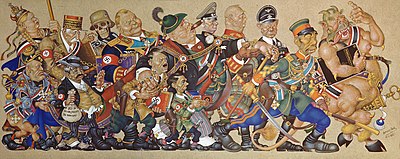
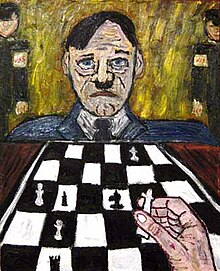
Salvador Dalí painted several pictures involving Hitler. The Enigma of Hitler (1939) depicts a torn photograph of Hitler on a plate in a typically surreal landscape over which hangs a broken telephone and an umbrella.[48] He also painted the Metamorphosis of the Face of Hitler into a Moonlit Landscape (1958). One of his late works was Hitler Masturbating (1973), depicting just that, with Hitler seen from behind in an armchair in the center of a snow-filled desolate landscape.
Hitler is depicted in a balloon overlooking marching, helmeted troops in the painting Vision of War by Indian artist A. Ramachandran. A picture of him with Gandhi by M. F. Husain was controversial with Hindutva groups in India.
In India[]
The name "Hitler" is widely used for anyone who is overly authoritarian in manner, but it does not have the same negative connotation as it does in the West. For example in the 1998 film Hitler, the disciplinarian hero nicknamed Hitler is simply a person with staunch traditional values.[49] There are at least three other Indian films entitled "Hitler", in all of which the Hitler character is the hero (Hitler (1996 film); Hitler (1997 film); Hitler Umanath). Hitler Didi (My Sister Hitler) is a TV show about a character with a domineering elder sister.
Hitler is also used as a personal name in India, as in the case of the politician Adolf Lu Hitler Marak. The film Hero Hitler in Love is about a man called "Hitler" who tries to love everyone. Furthermore, the swastika has for centuries been a common symbol in India with positive connotations. According to The Indian Republic,
A more recent cinematic outing- Gandhi to Hitler (2011) was decried for painting the man as a lost hero of India’s struggle for Independence while Hitler memorabilia, including his autobiography Mein Kampf, continues to grow in sales. In 2006, a Mumbai restaurant was forced to change its name from the ill advised "Hitler’s Cross" while in 2012, a clothing store named "Hitler" in Ahemdabad drew considerable anger (tellingly the owner of the unfortunately named store said that he had picked the name in memory of his grandfather, a strict disciplinarian who the family referred to as "Hitler").[49]
According to Navras Jaat Aafreedi, such references to Hitler are not usually linked to pro-Nazi sympathies, but some Hindu nationalist groups see Hitler's use of the swastika as a "great service to Hinduism" and link anti-Semitic ideology to anti-Islamism.[49]
The "Hitler" clothing store in Ahmedabad in Gujarat opened in mid-August 2012. The store immediately became embroiled in controversy over its name.[50] The store's logo even had a swastika embedded in the dot above the "i" in Hitler's name. The owner, Rajesh Shah, told media he did not expect all the commotion. He had chosen the name because the grandfather of his business partner was nicknamed "Hitler" because of his strict demeanor. He added to the media that he also hadn't known about Hitler's until after the store's opening. He stated he did not intend to change the name unless somebody else paid the expenses. Among the groups that objected to the store's name was the small Jewish community in Ahmedabad. A diplomat at the Israeli embassy in New Delhi said that the embassy would protest in "the strongest terms possible" to the Indian government. The Israeli consul general in Mumbai asked state officials to ensure the store was renamed,[51] but commented that she believes the use of the name most likely is a product of ignorance rather than antisemitism.[52] Reports suggested that the shop owner had agreed to rename the store following an offer by a Jewish organization to pay the costs. In October 2012 the Ahmedabad Municipal authorities allegedly removed the store sign without proper procedure.[53] It was later renamed Gladiator.[54]
Cross Cafe in Mumbai was formerly Hitler's Cross cafe. The business sought to attract attention by using the Hitler theme, and was decorated with Nazi imagery. Actor Murli Sharma attended the opening party; when asked what he thought about the name, he said "I am not really agitated as I have not read much about the man. However, from what I know about Hitler, I find this name rather amusing."[55] Alternative names suggested included Stalin Samosa Shop, Ayatollah Khomeini's Falafels, and Kim Jong's Juicy Juice.[56]
In Thailand[]
Hitler Fried Chicken is a fast-food restaurant in Thailand based on Yum! Brands Kentucky Fried Chicken restaurant chain.[57] The mascot of Hitler Fried Chicken is Adolf Hitler wearing a Colonel Sanders outfit. Adolf Hitler is considered 'chic' by many in Thailand.[58]
See also[]
Notes[]
- ^ Cocks, Geoffrey (Autumn 1979). "The Hitler Controversy". Political Psychology. International Society of Political Psychology. 1 (2): 67–81. doi:10.2307/3791103. JSTOR 3791103.
- ^ "Israel wants Indian menswear shop Hitler renamed". CBS News. September 3, 2012. Retrieved 19 October 2014.
- ^ "An attempt to fathom Hitler / Robert Carlyle conveys depths of tyrant's evil". San Francisco Chronicle. May 16, 2003. Retrieved 19 October 2014.
- ^ Erickson, Hal (2014). "Hitler: The Rise of Evil (2003): Movie review". Movies & TV Dept. The New York Times. Baseline & All Movie Guide. Archived from the original on 27 October 2014. Retrieved 19 October 2014.
- ^ Victor, G. (1999). Hitler: The Pathology of Evil. Potomac Books. ISBN 1-57488-228-7.
- ^ Rosenbaum, R. (1999). Explaining Hitler: The Search for the Origins of His Evil. Harper Perennial. ISBN 0-06-095339-X.
- ^ Johnson, E. (2000). Nazi Terror: The Gestapo, Jews, and Ordinary Germans. Basic Books. ISBN 0-465-04908-7.
- ^ Levenda, P. (2005). Unholy Alliance: A History of Nazi Involvement with the Occult. Continuum. ISBN 0-8264-1409-5.
- ^ A. J. Goldman (3 November 2010). "Why Did Germans Embrace Him?". The Wall Street Journal. Retrieved 20 October 2014.
Nazis are never far from the news here, but 'Hitler and the Germans: Nation and Crimes' is Hitler's biggest coup in Berlin since Mel Brooks's 'The Producers' lit up the German capital last year. The exhibition at the German Historical Museum has attracted a mountain of domestic and international media attention and brisk business.
- ^ "Propaganda and the Visual Arts in the Third Reich". Yad Vashem. Retrieved 25 December 2018.
- ^ Welch, Professor David (17 February 2011). "Nazi Propaganda". BBC History. BBC. Retrieved 25 December 2018.
- ^ Hoberman, J. (6 March 2016). "'Triumph of the Will': Fascist Rants and the Hollywood Response". The New York Times. Retrieved 25 December 2018.
- ^ Sayre, Nora (6 December 1973). "Lang's 'Testament of Dr. Mabuse,' at Cultural Center Tomorrow:The Cast". The New York Times. Retrieved 25 December 2018.
- ^ "Home Cinema @ The Digital Fix - The Testament of Dr. Mabuse". Dvdtimes.co.uk. 2004-03-22. Retrieved 2011-01-11.
- ^ Cronin, Brian (4 October 2008). "Stars of Political Cartooning - David Low". CBR.com. Retrieved 25 December 2018.
- ^ "The Nazi-Soviet Pact". BBC. p. 2. Retrieved 25 December 2018.
- ^ Tim Masters (25 September 2013). "Henry Goodman on Brecht's Hitler satire Arturo Ui". BBC News. Retrieved 21 October 2014.
- ^ "Don't Bash Brecht". The Guardian. May 2008.
- ^ Dancis-McClatchy, Bruce (4 September 2018). "They used nyuk-nyuks against Nazis". The Charlotte Observer. Retrieved 25 December 2018.
- ^ Lenburg, Jeff; Maurer, Joan Howard; Lenburg, Greg (1994). The Three Stooges scrapbook. New York: Citadel Press. ISBN 0-8065-0946-5.
- ^ Kürten, Jochen (11 December 2015). "When Charlie Chaplin imitated Adolf Hitler". Deutsche Welle. Retrieved 25 December 2018.
- ^ Chalakoski, Martin (29 April 2017). "Chaplin's The Great Dictator might be the most popular, but it was The Three Stooges who first openly mocked Hitler on film". The Vintage News. Retrieved 25 December 2018.
- ^ Novick, Peter (2000). The Holocaust in American Life. Houghton Mifflin Harcourt. pp. 19–24. ISBN 978-0-618-08232-2.
- ^ Jump up to: a b Dibbits, Kat (22 January 2009). "Hitler - my part in his downfall". The Bolton News. Retrieved 25 December 2018.
- ^ Una Hajdari (23 December 2014). "On je sa Kosova, izgleda kao Hitler i od toga dobro živi" [He's From Kosovo, Looks Like Hitler and Earns a Living That Way] (in Serbian). Vice Serbia. Retrieved 25 December 2014.
- ^ Christie's auction results for 'Bound To Fail' sale
- ^ French, Jackie. "Results for 'Hitler fiction'". Worldcat.org. Retrieved 2011-01-11.
- ^ Published in Asimov's Science Fiction, July 1991.
- ^ Thomas Badtke: "'Bild' finanzierte den Führer: Adolf Hitler - Er ist wieder da!" book review. Retrieved April 04, 2013.
- ^ Kharunya Paramaguru: "He’s Back: Hitler Satire Tops Germany’s Best-Seller List". Retrieved April 04, 2013.
- ^ Sarah Ing (2014). "Countdown to War". Movies & TV Dept. The New York Times. Baseline & All Movie Guide. Archived from the original on 11 August 2014. Retrieved 21 October 2014.
- ^ "Hitler – Ein Film aus Deutschland" [Hitler – A Film from Germany]. German Films. Archived from the original on 13 May 2008. Retrieved 2008-05-22.
- ^ Waller, J. Michael (2007). Fighting the War of Ideas Like a Real War. Lulu.com. p. 101. ISBN 978-0-615-14463-4.[self-published source]
- ^ "Mein Kampf (2009)". IMDb. Retrieved 21 October 2014.
- ^ "Ordinary German tries to kill Hitler in '13 Minutes'". Boston Herald. MediaNews Group, Inc. 28 July 2017. Retrieved 26 January 2019.
- ^ "Brainiape/Hitler's profile at Comic Book Gorillarama". Archived from the original on 2004-08-04.
- ^ Arul, Davin (2016-03-22). "Review: Shigeru Mizuki's Hitler". The Star. Retrieved 2020-03-19.
- ^ The Doug Anthony Allstars; Paul McDermott; Tim Ferguson; Richard Fidler (1992). DAAS Kapital (scriptbook). Australia: Allen & Unwin. p. 33. ISBN 1-86373-101-6.
- ^ Stephen Matchett (11 October 2008). "There's life after Downfall". The Australian. Archived from the original on November 22, 2008. Retrieved 22 October 2014.
"YouTube Hitler parodies go viral". 2008-10-21. Archived from the original on 5 December 2008. Retrieved 2008-10-21. - ^ Video on YouTube
- ^ Video on YouTube
- ^ Finlo Rohrer (2010-04-21). "Downfall filmmakers want YouTube to take down Hitler spoofs". The Guardian. London. Archived from the original on 22 April 2010. Retrieved 2010-04-21.
- ^ "Everyone Who's Made a Hitler Parody Video, Leave the Room | Electronic Frontier Foundation". Eff.org. 2010-04-20. Archived from the original on January 8, 2011. Retrieved 2011-01-11.
- ^ Melanson, Mike (2010-04-22). "YouTube Weighs In on Hitler, Parodies, Mashups & Fair Use". Readwriteweb.com. Archived from the original on 2010-11-14. Retrieved 2011-01-11.
- ^ "Darth Vader vs Hitler. Epic Rap Battles of History 2". YouTube. Retrieved 23 October 2014.
- ^ "Hitler vs Vader 2. Epic Rap Battles of History Season 2". YouTube. Retrieved 23 October 2014.
- ^ "Hitler vs Vader 3. Epic Rap Battles of History Season 3". YouTube. Retrieved 23 October 2014.
- ^ Paloma Esteban Leal. "Salvador Dalí - The Enigma of Hitler". Reina Sofía Museum. Retrieved 5 March 2017.
- ^ Jump up to: a b c "Is Hitler loved in India?", The Indian Republic, Wednesday, 20 August 2014.
- ^ Nelson, Dean (August 29, 2012). "India's Jewish community condemn 'Hitler' clothes shop". The Daily Telegraph. Archived from the original on August 30, 2012. Retrieved August 30, 2012.
- ^ "Israel wants Indian menswear shop Hitler renamed". CNN. September 3, 2012. Retrieved September 3, 2012.
- ^ "Hitler-butikk vekker avsky" [Hitler store engenders disgust]. Verdens Gang (in Norwegian). AFP. August 29, 2012. Archived from the original on August 29, 2012. Retrieved August 29, 2012.
- ^ AMC turns ‘Hitler’ at Vastrapur store, Owners of garment store approach police commissioner, claim civic officials removed their signboard without serving a notice, Ahmedabad Mirror Bureau, October 31, 2012
- ^ Gladiator Fashion Ahmedabad CityShor
- ^ Tunzelmann, Alex von (2010-06-11). "Why Bollywood's film about Hitler is profoundly misguided". The Guardian. London. Retrieved April 17, 2011.
- ^ In India, a café named Hitler's Cross, Anand Giridharadas, August 24, 2006
- ^ Merwin, Hugh (2013-07-08). "Hitler-Themed Chicken Restaurant in Thailand Ruffles Many Feathers". Grub Street. New York. Retrieved January 23, 2019.
- ^ Kraus, Tibor (2012-02-27). "Bangkok's 'Hitler chic' trend riles tourists, Israeli envoy". CNN. New York. Retrieved January 23, 2019.
References[]
- Faschismus in der populären Kultur [Fascism in popular culture] by Georg Seesslen Berlin : Edition Tiamat, 1994–1996. ISBN 3-923118-24-4, OCLC: 80476144
- The world Hitler never made : alternate history and the memory of Nazism by Gavriel David Rosenfeld. Cambridge ; New York : Cambridge University Press, 2005. ISBN 0-521-84706-0 OCLC: 58052431
- Hitler's imagery and German youth by Erik H Erikson; Berkeley, Calif. : Institute of Child Welfare, University of California, 1940-1950? OCLC: 26533155
Further reading[]
- Butter, Michael. The Epitome of Evil: Hitler in American Fiction, 1939-2002. Palgrave Macmillan, April 28, 2009. ISBN 0230620809, 9780230620803.
- Cultural depictions of Adolf Hitler
- Internet memes
- Works about Adolf Hitler
- Lists of music by theme
- Politics in popular culture
- Celebrities in popular culture
- World War II in popular culture
- Nazism in popular culture
- Germany in popular culture
